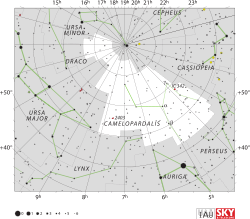Alpha Camelopardalis
| Observation data ICRS )
| |
|---|---|
| Constellation | Camelopardalis
|
| Right ascension | 04h 54m 03.01040s[1] |
| Declination | +66° 20′ 33.6365″[1] |
| Apparent magnitude (V) | 4.29[2] |
| Characteristics | |
| Spectral type | O9Ia[3] |
| U−B color index | −0.87[2] |
| B−V color index | +0.05[2] |
| R−I color index | 0.00[2] |
| Absolute magnitude (MV) | –7.1[5] |
| Details Myr | |
| 04490+6615 | |
| Database references | |
| SIMBAD | data |
Alpha Camelopardalis,
Description
Alpha Camelopardalis has a stellar classification of O9 Ia, with the 'Ia' indicating that it is an O-type luminous supergiant. It is a massive star with 37.6 times the mass of the Sun and 32.5 times the Sun's radius. The effective temperature of the outer envelope is 29,000 K; much hotter than the Sun's effective temperature of 5,778 K, giving it the characteristic blue hue of an O-type star.[8] It is emitting 676,000 times the luminosity of the Sun and is a weak X-ray emitter.[9]
Variations in the profiles of Alpha Camelopardalis' spectral lines are caused by fluctuations in the
In 1968, this star was classified as a
In 1961, based on the criteria that the
Runaway stars such as this with a stellar wind that is moving at supersonic velocity through the interstellar medium have their wind confined by a bow shock due to ram pressure. The dust in this bow shock can be detected using an infrared telescope.[14] Just such a bow shock was observed with NASA's Wide-field Infrared Survey Explorer, or WISE. The star is traveling at a rate of somewhere between 680 and 4,200 kilometers per second: between 1.5 and 9.4 million mph.[15]
Chinese name
In
References
- ^ S2CID 18759600.
- ^ Bibcode:2002yCat.2237....0D.
- S2CID 119248206.
- Bibcode:1953GCRV..C......0W
- ^ See Table 1.
- .
- ^ Bibcode:1961BAN....15..265B
- Commonwealth Scientific and Industrial Research Organisation, December 21, 2004, archived from the originalon March 18, 2012, retrieved 2012-01-16
- doi:10.1086/110378
- S2CID 14180933
- S2CID 18121243
- S2CID 15819352
- doi:10.1086/191208
- doi:10.1086/118298
- ^ Clavin, Whitney (March 11, 2011), "Speed demon creates a shock", physorg, retrieved 2011-12-24
- ISBN 978-986-7332-25-7.
- ^ (in Chinese) AEEA (Activities of Exhibition and Education in Astronomy) 天文教育資訊網 2006 年 6 月 11 日 Archived 2011-05-22 at the Wayback Machine
- ^ English-Chinese Glossary of Chinese Star Regions, Asterisms and Star Name Archived 2008-09-24 at the Wayback Machine, Hong Kong Space Museum. Accessed on line November 23, 2010
- ^ Bibcode:1899sntm.book.....A, retrieved 2011-12-24
External links
- HR 1542, entry in the Bright Star Catalogue
- Alpha Camelopardalis in Aladin
- Image of the constellational matrix formed by viewing the constellational lines at 16,000 light-years from the sun. Spike at the left is Alpha Camelopardalis.

